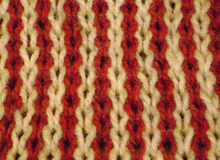Popularity of knitted fabrics has grown tremendously in recent years because of the increased versatility of techniques, the adaptability of many new manmade fibres and the growth in consumer demand for wrinkle resistant, stretchable, snug-fitting fabrics, particularly in the greatly expanding areas of sportswear, other casual wearing apparel and even in applications like medical or construction textiles.
Introduction:
The word knitting is derived from knot and ultimately from the Old English cnyttan, to knot.
Knitting is a method by which yarn is manipulated to create a textile or fabric; it is used in many types of garments. Knitting may be done by hand or by machine.
Knitting creates stitches: loops of yarn in a row, either flat or in the round (tubular). There are usually many active stitches on the knitting needle at one time.
Knitted fabric consists of a number of consecutive rows of connected loops that intermesh with the next and previous rows. As each row is formed, each newly created loop is pulled through one or more loops from the prior row and placed on the gaining needle so that the loops from the prior row can be pulled off the other needle without unravelling.
Like weaving, knitting is a technique for producing a two-dimensional fabric made from a one-dimensional yarn or thread.

If yarn in a traditional knitted fabric breaks, the loops unravel and a run or ladder forms. To overcome the problem, and also to sell more goods, knitters worked to design new fabric structures that were less dependent on individual loops for their strength and unlikely to run if a thread broke. Hexagonal meshes, micro-mesh, non-run, run-proof and similar fabrics were introduced and appreciated by consumers.
Some of the most popular types of knitted fabric:
Warp knitted fabrics:
1. Raschel: The fabric has an openwork pattern and three-dimensional surface effect.
2. Tricot: The fabric is a mix of natural and synthetic materials. It features lengthwise ribs on the right side and crosswise ribs on the wrong side. Tricot knit fabric is soft and has good drapability.
3. Milanese knit: The fabric is knitted diagonally from two sets of yarns. It is soft, lightweight and run-resistant.
Weft knitted fabrics:
• Single knit:
Single Jersey: It has two different sides with vertical ribs on the right one and horizontal ribs on the wrong side. The fabric curls towards the right side. Jersey is the most popular type of knit fabrics due to a variety of colors, patterns and useful consumer properties – it is comfy, soft and stretchy.
• Double knit:
1. Interlock: Unlike jersey, both sides of interlock knit are with lengthwise ribs and look the same way. The fabric features good shape retention, medium or heavy weight, smooth texture.
2. Rib: It has visible vertical ribs on both sides. The fabric features a perfect crosswise stretch and a soft feel.
3. Purl: The fabric is double-faced and has 2-way stretch (crosswise, lengthwise). It features knit and purl stitches which form columns, going along the length of the fabric.
Specialized Weft Knits
• Intarsia
• Jacquard Jerseys
• Knitted Terry
• Knitted Velour
• Sliver Knit
• Fleece
• French Terry
APPLICATIONS:
Knit fabrics are versatile and it’s application are not only in clothing but also home furnishings, technical textiles, industrial uses, medical purposes and geotextiles as well. Knits are striking, inviting, durable, surprisingly easy and quick to manufacture
Home furnishing: Knitted terry towels are being widely used. Knitted velour is used in upholstery.
Functional textiles: A functional textile may include various requirements such like antibacterial, moisture management, flame-retardant, antistatic effect, water repellant, and so on. These are formed by weaving, knitting, crocheting, knotting or pressing fibres together. But when it comes to sports and casual clothing, consumers now-a-days are not only seeking fashion, but ergonomics, especially comfort and health, which can be best provided by knitted fabrics.
Medical textiles: Medical textiles is one of the major growth areas within technical textiles and the use of textile materials for medical and healthcare products ranges from simple gauze or bandage materials to scaffolds. It is not surprising that a great part of clothing worn by doctors and nurses in hospitals and clinics is product of the knitting industry (eg, undershirts, socks). But sometimes they are not conventional ones, they are made from yarns or with finishing that make them antibacterial against infections or against of rising of unpleasant sweaty smell. Various types of bandages (both rigid and elastic), surgical stockings, certain parts of orthopedic equipment (like knee-, wrist- and elbow-braces, calf and lumbar supports, etc) are also made by knitting technology.
Industrial applications: Knitted wire mesh is a highly versatile, highly functional material with a wide range of applications. Particularly useful in hostile environments, it is manufactured from wire types chosen to match specific operating requirements such as temperature extremes or corrosives.
Filters and geotextiles: Stitch bonded knitted are used very often as reinforcing materials in composites or for heat or sound insulation, filling materials in clothes or furniture, etc. Stitch bonding machines combine knitting and sewing. They have grown from warp knitting technology and their products occupy an intermediate position between knitted and nonwoven fabrics. This fabric contains a carded web, which is reinforced by yarns or loops formed from fibres pulled out from the web itself.
Conclusion:
Knitted fabrics are versatile in their range from apparel to medical textiles. Knitted fabrics are important in all applications of textiles and fully fashioned garment. Knitted garment are very popular in the modern fashion scene. Knitted garment are no longer confined to lingerie, underwear and stockings. There has been a revolution in knitwear. Knitwear has become popular for all — men, women and kids. These are the fabrics of the generation-next: cool, comfortable, easy care and stylish.
Reference:
Wikipedia contributors. Knitting. Retrieved from https://en.m.wikipedia.org/wiki/Knitting
Knit Fabric Guide: Types, Pros and Cons, Sewing Tips. Retrieved from https://tissura.com/articles/knit-fabrics
Knitting. Retrieved from https://www.textileschool.com/251/knitted-fabrics-and-types/
Retrieved from https://indiantextilejournal.com/articles/FAdetails.asp?id=4761
-Manali Bhanushali.
